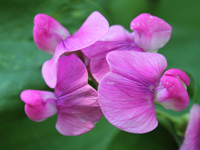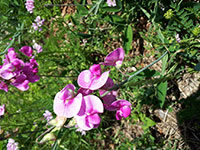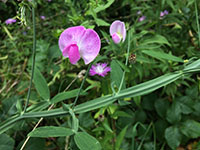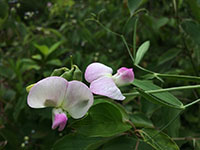![]()
The Everlasting Pea (Lathyrus latifolius) is a brightly colored and hardy perennial vine belonging to the pea family (Fabaceae). Native to Europe, this vigorous plant has been introduced to various other continents, where it has successfully naturalized in different environments. It is commonly found growing along roadsides, ditches, and disturbed areas, often forming dense, sprawling masses that can spread aggressively. Due to its rapid growth and resilience, Everlasting Pea is frequently used as a ground cover or ornamental plant in gardens, though it has a tendency to become invasive in some areas.
The botanical name of the plant reflects its characteristics, with Lathyrus being the Latin term for "pea" and latifolius meaning "broad-leaved," a reference to its distinctive foliage. Unlike the closely related annual Sweet Pea (Lathyrus odoratus), with which it is sometimes confused, Everlasting Pea lacks fragrance, making it an exception among many cultivated peas that are known for their scent. Despite its showy, pea-like flowers in shades of pink, purple, and white, the plant is often regarded as a weed due to its ability to spread persistently and establish itself in areas where it is not always welcome. Once introduced to a location, it can be challenging to remove, as it spreads through both seeds and underground rhizomes. While it remains a popular choice for erosion control and as a pollinator-friendly plant, its aggressive growth can sometimes make it a troublesome species in managed landscapes.
![]()
Everlasting Pea has been used for ground stabilization along roadways and ditches to prevent soil erosion.
![]()
Within the realm of rational and holistic medicine, there are no known uses for everlasting pea.
Please note that MIROFOSS does not suggest in any way that plants should be used in place of proper medical and psychological care. This information is provided here as a reference only.
![]()
Some reports suggest the seeds are edible if cooked, however these should be treated with extreme caution due to the TOXICITIY of the plant.
Please note that MIROFOSS can not take any responsibility for any adverse effects from the consumption of plant species which are found in the wild. This information is provided here as a reference only.
![]()
The Everlasting Pea (Lathyrus latifolius) is a highly adaptable plant capable of thriving in a wide range of environmental conditions. It can grow in both full sun and partial shade, making it well-suited to various landscapes, including roadsides, ditches, and areas with disturbed soil. Its robust nature allows it to establish itself in medium loamy soils as well as heavier clay soils, where many other plants struggle to grow. Additionally, Everlasting Pea is tolerant of a broad pH spectrum, flourishing in acidic, neutral, and alkaline soils, making it a versatile species in diverse habitats.
One of the plant's notable characteristics is its ability to tolerate both dry and moist soil conditions. While it prefers moderate moisture, it is also remarkably drought-resistant, making it an excellent choice for areas with inconsistent rainfall. This resilience allows it to persist in a variety of climates, contributing to its widespread naturalization beyond its native European range. Furthermore, as a member of the pea family (Fabaceae), Everlasting Pea plays a valuable ecological role by improving soil health. Like many legumes, it has the ability to fix nitrogen in the soil, helping to enrich the surrounding environment by increasing soil fertility. This makes it beneficial for restoring degraded soils and supporting the growth of other plants in its vicinity.
Another advantage of Everlasting Pea is its resistance to deer browsing. While many plants are susceptible to damage from grazing animals, this species appears to be largely unpalatable to deer, allowing it to persist in regions where herbivory pressure is high. This deer resistance, combined with its vibrant flowers, makes it an appealing yet low-maintenance choice for gardeners and land managers looking for a hardy, ornamental, and ecologically beneficial plant. However, due to its vigorous growth and spreading habit, it should be monitored carefully in cultivated landscapes to prevent it from becoming invasive.
| Soil Conditions | |
| Soil Moisture | |
| Sunlight | |
| Notes: |
![]()
The Everlasting Pea (Lathyrus latifolius) is a vigorous perennial vine that can grow up to 180 centimeters in length, primarily using its twining tendrils to climb nearby structures, fences, or vegetation. In open, unsupported areas, the plant tends to sprawl along the ground, creating dense mats of foliage. Though it spreads relatively slowly, its persistence allows it to establish itself in various habitats. As the growing season progresses, the foliage begins to thin out and turn yellowish, signaling the plant’s seasonal decline.
The stems of the Everlasting Pea are winged and hairless, supporting alternating compound leaves that consist of a single pair of leaflets and a winged petiole about 5 centimeters long. The leaflets are narrow, ovate to oblong-ovate in shape, with smooth margins and a hairless texture. They can grow up to 75 millimeters in length and 25 millimeters in width. Between the leaflets, the plant produces branched tendrils, which aid in climbing and anchoring the vine to surrounding vegetation.
Throughout the summer and early autumn, the Everlasting Pea produces racemes of four to eleven unscented flowers, emerging from the axils of the leaves. The flowers, which measure about 25 millimeters across, exhibit the classic structure found in many members of the pea family, with an upper "standard" petal and a lower "keel" enclosed by two lateral petals. The five-petaled flowers are a purplish-pink hue, gradually fading as they age. A green calyx with five often-unequal teeth supports the flower. The blooming period lasts approximately two months, providing a long display of color in naturalized and cultivated settings.
After the flowering season, the blossoms are replaced by hairless, flattened seedpods measuring about 5 centimeters in length and 1 centimeter in width. These seedpods start off green but eventually turn brown as they mature. Once fully ripe, the pods split open into curled segments, forcefully ejecting the seeds to aid in dispersal. The seeds are dark in color and vary in shape from oblong to kidney-like (reniform). While bumblebees play a crucial role in pollinating the flowers, butterflies often visit to feed on the nectar but do not contribute to pollination. Certain caterpillar species feed on the plant’s foliage, though most animals avoid consuming the seeds, as they are toxic.
Everlasting Pea is capable of reproducing both vegetatively and through reseeding. It spreads underground via a taproot and rhizomes, allowing it to persist even in challenging conditions. Its ability to regenerate from both seeds and roots contributes to its tenacity, making it a long-lasting and sometimes invasive presence in gardens, roadsides, and wild spaces. Despite its aggressive tendencies, it remains a popular ornamental plant, appreciated for its striking flowers and ability to attract pollinators.
![]()
| Plant Height | 180cm | 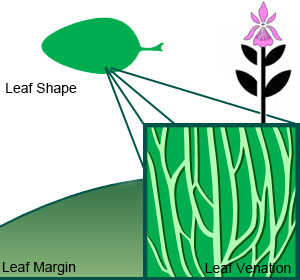 |
| Habitat | Cultivated areas, Disturbed Soil, Roadsides, Ditches | |
| Leaves | Ovate | |
| Leaf Margin | Entire | |
| Leaf Venation | Longitudinal | |
| Stems | Smooth stems | |
| Flowering Season | June to September | |
| Flower Type | Bilaterally Symmetrical | |
| Flower Colour | Pink | |
| Pollination | Bees | |
| Flower Gender | Flowers are hermaphrodite and the plants are self-fertile | |
| Fruit | Small seeds in a swollen capsule | |
| USDA Zone | 3A (-37°C to -40°C) cold weather limit |
![]()
The following health hazards should be noted when handling or choosing a location to plant everlasting pea:
 |
TOXIC The seeds of everlasting pea contain a toxic amino acid that can cause a severe disease of the nervous system known as 'lathyrism' if they are eaten in large amounts. |
![]()
 |
-Click here- or on the thumbnail image to see an artist rendering, from The United States Department of Agriculture, of everlasting pea. (This image will open in a new browser tab) |
![]()
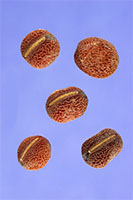 |
-Click here- or on the thumbnail image to see a magnified view, from The United States Department of Agriculture, of the seeds created by everlasting pea for propagation. (This image will open in a new browser tab) |
![]()
Everlasting Pea can be referenced in certain current and historical texts under the following four names:

![]()
 |
What's this? What can I do with it? |
![]()
| Dickinson, T.; Metsger, D.; Bull, J.; & Dickinson, R. (2004) ROM Field Guide to Wildflowers of Ontario, Royal Ontario Museum, Toronto:McClelland and Stewart Ltd. | |
| C. Brickell, Encyclopedia of Garden Plants, 1996, Royal Horticultural Society, London, ISBN 0-7513-0436-0. | |
| F. Chittendon. RHS Dictionary of Plants plus Supplement. 1956 Oxford University Press 1951 | |
| USDA-NRCS PLANTS Database / USDA NRCS. Wetland flora: Field office illustrated guide to plant species. USDA Natural Resources Conservation Service. | |
| National Audubon Society. Field Guide To Wildflowers (Eastern Region): Alfred A. Knopf. ISBN 0-375-40232-2 | |
| February 23, 2025 | The last time this page was updated |
| ©2025 MIROFOSS™ Foundation | |
 |
|

